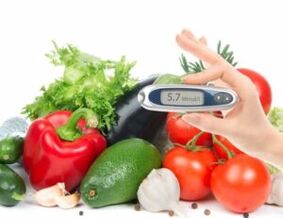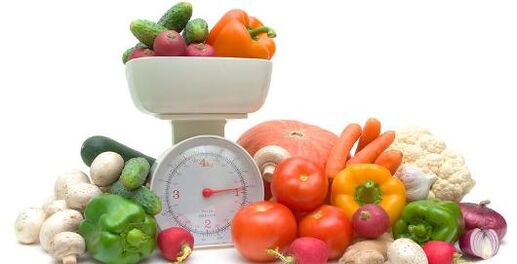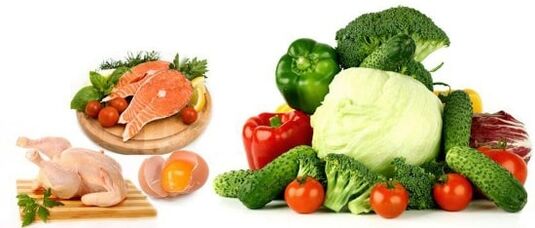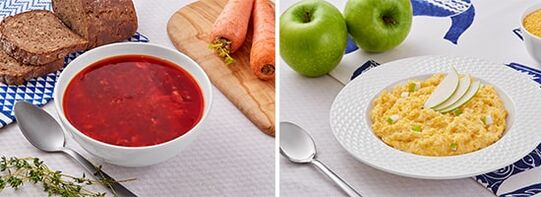
Diabetes mellitus is a chronic endocrine pathology in which the metabolism is disrupted due to a lack or malfunction of the hormone insulin.
A distinction is made between insulin-dependent (type 1) and non-insulin-dependent (type 2) diabetes.
In the first case, patients will need to inject insulin because their body is not producing enough of the hormone or is completely missing it.
In the second type, the interaction of insulin with the cells is disrupted.
Despite the different mechanisms of pathology, the main role in therapy is attributed to diet.
Dietary characteristics of diabetics
In the past, a food inhibition system was the only way to curb hyperglycemia or high glucose levels. Now patients ’diets have expanded significantly. Diabetics need to follow several important rules to effectively control their blood sugar.
Patients should not starve or overeat. These conditions are dangerous to their health. It should be eaten so that the amount of carbohydrate consumed is evenly distributed throughout the day.
General nutritional requirements:
- fractional diet (at least 6 times a day);
- calculation of carbohydrates consumed;
- restriction of animal fats;
- introduction of plant foods into the diet;
- prefer steamed food, oven, cooked;
- avoiding or restricting foods that increase carbohydrate loads;
- balanced diet;
- substitution of sugar by substitutes;
- consumption of coarse fiber foods;
- adherence to the drinking system;
- reducing salt intake;
- elimination of alcohol.
You can diversify your diet by buying dishes that allow you to cook food without oil.
In order to ensure that carbohydrates are absorbed more slowly and do not cause jumps in your blood sugar, it is a good idea to follow these recommendations:
- Eat coarse or granular foods such as crushed cereals instead of crushed or cooked.
- Food should not be hot as temperature affects glucose uptake.
- Fibers in foods inhibit the absorption of simple carbohydrates and help remove cholesterol.
- Simple carbs should be consumed after the main meal.
The menu may include foods that contain simple carbohydrates with fiber, such as fruits and berries. The absorption of glucose is slowed down when taken with proteins (protein cream) or fats. However, keep in mind that "slow" carbohydrates are also absorbed into the bloodstream, increasing sugar.

Nutritional differences in type 1 and type 2 diabetes mellitus
Because the causes of the increase in blood sugar in the first and second types of the disease are different, there are several approaches to patients ’diets. The diet of insulin-dependent patients is more varied. Because they are more likely to suffer from this pathology at a young age, they include high-calorie foods in their diet. The units of cereal consumed are taken into account when compiling the diet.
In type 2 diabetes, the main task of nutrition is to lose weight. In this case, the menu is calculated based on the caloric content of the products. The patient's diet is stiffer. They should not consume sugar, fatty foods and foods that increase cholesterol.
Bread unit

The term "bread unit" (XE) has been introduced to take account of the quantitative composition of carbohydrates. For 1 XE, this is 25 g of bread or 12 g of sugar (carbohydrate). A diagram of bread units is needed to calculate the short insulin given to diabetics.
1 XE requires 2-4 units. insulin. The individual need for XE supplemental insulin is determined using a self-monitoring diary that the patient should keep.
A diabetic can eat up to 7 XE during a meal. The main carbohydrate load occurs in the first half of the day.
In order not to continuously calculate the bread units with the weight of the products, tables were prepared taking into account the energy value of the products.
What is the glycemic index of foods
The Glycemic Index (GI) is an indicator of how much your blood sugar level can rise compared to taking glucose.
Foods with a high GI (70 or more):
- Honey,
- glucose;
- sugar;
- potato puree;
- sweet soda;
- sweets - corn sticks, puffed rice.
Average GI (56-69):
- melon;
- banana;
- cereal;
- black bread.
Lowest GI:
- dairy products;
- milk;
- fruits;
- peas, beans, lentils and other legumes.
The rate of absorption is affected by cooking, food integrity, and temperature.
Only foods with moderate to low GI are allowed in diabetes mellitus.
List of permitted and prohibited products
The dietary principles of diabetics with different types of diseases are different. However, there are foods that endocrinologists do not recommend eating.
The list of prohibited foods includes:
- baked potatoes, fries, chips;
- sweet fruits - grapes;
- fatty meats;
- smoked meats;
- canned foods in oil;
- pies;
- sweet curd, curd mass;
- sweet yoghurts;
- margarine;
- white bread and white floury pastries;
- fruit juices from the store;
- soda;
- alcohol;
- confectionery, chocolate;
- jam;
- condensed milk;
- fast food.
Patients should love these foods and drinks:
- mineral water;
- rosehip compote;
- vegetable juices;
- freshly squeezed juices of sweet and sour berries and fruits;
- unsweetened citrus fruits;
- frozen and fresh berries;
- low fat dairy products without sugar;
- dietary meat - chicken, turkey, veal, rabbit meat;
- Cabbage;
- legumes;
- mushrooms;
- tomato;
- eggplant;
- greens;
- asparagus;
- broccoli;
- milk;
- wholemeal baked goods;
- Seafood;
- fish.
To reduce the starch content of vegetables and cereals, it is recommended to soak them before cooking.
Rules for compiling the menu
When compiling the menu, it is worth considering not only the carbohydrate load and caloric content of the food, but also the activity of the diabetic. Exercise lowers blood sugar. For type 1 diabetes, it is recommended that you take 1 XE after each hour of physical activity. This will prevent you from adjusting your bolus insulin dose.
In the case of obesity, the dietitian helps to plan the diet, taking into account the energy content (calories) of the food and the daily energy consumption during physical activity. The calculation takes into account the patient's gender, age, and degree of obesity. It is possible to organize fasting days (for type 2 diabetes). However, fasting is contraindicated in such patients.
The general condition of the diabetic is taken into account when preparing the menu. Pregnant and lactating women, adolescents and debilitated patients require protein intake. If the patient has kidney or liver damage, ketoacidosis, protein intake is reduced.
Do not forget about other nutrients involved in metabolism: vitamins, zinc, copper, manganese. Due to the predisposition of patients to cardiovascular pathologies, the salt content of foods decreases.
Sample menu for a week
Monday
- breakfast: buckwheat porridge, protein-bran bread with butter, tea;
- snack: cabbage salad with eggs;
- lunch: chicken soup, vegetable salad with herbs, green beans with white meat slices, compote, diabetic rye bread;
- afternoon snack: bread with yogurt;
- dinner: steamed zrazy with fish, rye bread, vegetable salad;
- snack: fermented milk drink.
Tuesday
- breakfast: oatmeal, buttered bread, tea;
- snack: salad of parsley, onion and mushrooms;
- lunch: pea soup, fried chicken with vegetables, vegetable salad, bread, drink;
- afternoon snack: fermented fried milk with biscuits;
- dinner: steamed fish with vegetables, cereal bread, juice;
- snack: yogurt.
Wednesday
- breakfast: porridge "Artek", protein-bran bread with butter, coffee;
- snack: salad of celery, apples and carrots;
- lunch: borscht, buckwheat porridge with steamed slices, sauerkraut salad, protein bran bread, compote;
- afternoon snack: with cottage cheese and fruit;
- dinner: with bigos sauerkraut and meat, protein bran bread, juice;
- snack: baked apple.
Thursday
- breakfast: eggs, rye bread with butter, tea;
- snack: cottage cheese with yoghurt;
- lunch: green borscht, fried eggplant with meat, tomato salad with low-fat sour cream, rye bread, compote;
- afternoon snack: cottage cheese pudding with tea;
- dinner: stew with vegetables, rye bread, drink;
- snack: bread with kefir.

Friday
- breakfast: barley porridge, buttered bread, tea (chicory, coffee);
- snack: fruit salad with yoghurt;
- lunch: fish soup, fish slices with vegetable garnish, bell pepper cucumber salad, cereal bread, citrus drink;
- afternoon snack: bread with milk;
- dinner: steams with milk sauce, porridge, cereal bread, lemonade;
- snack: fruit.
Saturday
- breakfast: veal omelette, protein-bran bread with cheese, tea;
- snack: cottage cheese with berries;
- lunch: mushroom soup, porridge with cooked (fried) meat, canned pea onions and herbs, protein bran bread, compote;
- afternoon snack: oatmeal biscuits with fermented fried milk;
- dinner: zucchini stuffed with meat, porridge, protein-bran bread, drink;
- snack: fermented fried milk.
Sunday
- breakfast: brown rice with minced meat and cabbage (cabbage rolls), rye bread with butter, tea;
- snack: bread with yogurt;
- lunch: soup with meatballs, omelette with chicken, red cabbage salad, rye bread, drink;
- afternoon snack: kefir with biscuits;
- dinner: fish cake, baked potatoes, rye bread, drink;
- snack: biscuits with milk.
The test menu is compiled by a nutritionist. In the future, the diabetic will supplement the diet himself, taking into account the doctor’s recommendations.
Ready meals for diabetics
To eat properly in diabetes, you need to spend a lot of time and effort. Most diabetics simply don’t have enough time to put together a menu and prepare food, so now I want to talk about Cryodieta, which helps make life easier for diabetics.
Cryodieta is the home delivery of ready-made and tasty food not only for diabetics but also for those who want to lose weight. The menu was compiled by knowledgeable professionals - nutritionists and doctors.
Thanks to the special "shock freeze" technology, all you have to do is reheat the food in a microwave or multicooker and eat deliciously. However, freezing retains all the nutrients.
The main advantages of "Cryodiet" are:
- production of products in the ecologically clean area of the Novgorod region;
- personal delivery without delay;
- various foods;
- shock freezing (keeps food without preservatives);
- more affordable prices compared to competitors.
Examples of food

Ready-to-eat meals for diabetics work in the big cities, so if you want to eat healthy diet food and don’t spend a lot of time on it, order a weekly menu on the official website.
Sugar substitutes
In order to prevent patients from suffering from a lack of sweets, a sweetener may be added to the food. They can be divided into three groups:
- Carbohydrates - fructose, sorbose, xylitol, sorbitol, molasses.
- Protein sweeteners - miraculin, monelin.
- Synthetic - aspartame, sodium cyclamate.
Endocrinologists recommend the use of the natural sweetener, stevia. Its leaves contain a complex of glycosides that is 200 times sweeter than sugar. The sweetener is beneficial for obesity, high cholesterol and high blood sugar. Due to its ability to normalize metabolism, stevia helps restore the liver's antitoxic function.
Plant glycosides stimulate immunity, lower sugar levels, have beneficial effects on the digestive system and endocrine system. Drinks containing stevia extract improve the craving for sugary and fatty foods and help get rid of extra pounds.
High blood sugar is not a deadly sentence for patients if they learn how to make a diet and use healthy sweets instead of sugar. Also, do not forget to consult your endocrinologist.































































